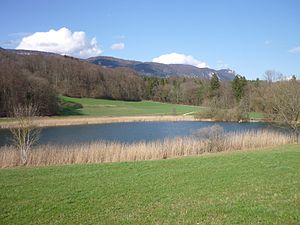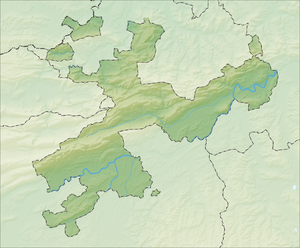Bellacher pond
| Bellacher pond | ||
|---|---|---|

|
||
| Geographical location | Bellach municipality , canton Solothurn , Switzerland | |
| Tributaries | Chalenbach | |
| Drain | Weierbach → Haltbach → Aare | |
| Data | ||
| Coordinates | 603 208 / 229 237 | |
|
|
||
| surface | 3.35 hectares | |
| Maximum depth | 2.2 m | |

|
||
| Frozen Bellacherweiher with ice-skaters | ||
The Bellacher Weiher (also spelled Bellacherweiher or Bellacher-Weiher ; according to the official maps simply Weier without an identifier) is a pond in the municipality of Bellach in the Swiss canton of Solothurn . It is located directly at the southern foot of the Jura and has an area of around 3.35 hectares and a maximum depth of 2.20 m.
history
The pond was originally intended to supply the city of Solothurn with fish. After Kurt Jäggi's depiction in the 1977 Bellacher calendar , a master Ulrich von Egliswil , dam builder, was commissioned by the city council in 1456 with the construction of today's pond. According to the Bellach village history from 1990, however, it was a different pond called Oberer Bellacher Weiher , which was later located in the Selzach municipality, while the pond that still exists today was dammed up as Seusetweiher or Unterer Bellacher Weiher in 1548 . It soon became apparent that the cost of introducing the fish was not in a favorable relation to the yield of the ponds. "The fishing out of the ponds was mainly a festival for the councilors themselves, who appeared in corpore and were fed with plenty of fish and wine." These celebratory meals for the Solothurn council reduced the proceeds considerably, as at least 101 council members and probably other guests took part. The council considered keeping the ponds or selling them several times, "but the pleasure of feasting always won out."
The pond also went down in the annals of the year 1798 , when the most important battle between the troops of Napoleon invading the country under General Schauenburg and the Solothurn troops of General Josef Bernhard Altermatt took place on its shores , with the French quickly winning and then without a fight Occupied Solothurn and the rest of the canton.
In 1861, the mechanical cotton weaving mill Schwarz & Co. took over the Bellacher Weiher and used the water that was routed to the weaving mill in a pipe to drive their machines. In the vernacular of Bellach, the pond has since been called the "Black Sea" or "Black Sea". The weaving mill also leased the pond for fishing. In 1945 it was declared a cantonal nature reserve. From 1955 the Bellacherweiher changed hands several times. In 2001 it was acquired by the Stöckli family.
In appropriate winter weather conditions, the Bellacher Weiher can be used for ice skating . Especially in the late 19th and early 20th centuries, it was so popular with ice skaters in the region that there was a festival restaurant on Sundays.
Until the beginning of the 20th century, the Bellacher Weiher was also used to obtain natural ice . It was also useful for the farmers, as they were allowed to use the runoff to irrigate their fields.
Siltation
For a long time, the Bellacher Weiher showed a tendency to silt up . Every summer it was almost completely overgrown by water lilies and milfoil . The subsequently sinking biomass formed a sludge layer of increasing thickness on the lake bed. As a result, the maximum water depth shrank from just under 3 m to 2.20 m between 1987 and 2004 alone. At the beginning of the 1960s, a part that had become swamp and reed area was filled in to gain cultivated land.
The current owner family is trying to stop the silting process and stabilize the pond. For this purpose, an experiment was carried out from 2004 to 2007 with the scientifically controversial Plocher system, which was supposed to improve the water quality through so-called “ informed ” materials. According to the final report of the project, this reduced the pH value and increased the oxygen content, and stopped the accumulation of digested sludge. Further measures are to be taken in cooperation with farmers in the area.
literature
- Kurt Jäggi: The Bellacher pond . In: Bellacher calendar . tape 1 , 1977, pp. 29-33 .
- David Horisberger, Stöckli family (ed.): Bellacher Weiher: On the trail of nature . 2004.
Web links
Individual evidence
- ↑ a b c Niklaus Rutishauser, David Horisberger: Renovation of the Bellacher Weiher with the Plocher technology, test phase 2004-2007: Final report (PDF) July 2008. Accessed on November 17, 2017.
- ↑ Kurt Jäggi: The Bellacher pond . In: Bellacher calendar . tape 1 , 1977, pp. 29 .
- ^ A b c Hans Sigrist: Rights and tasks of the community . In: Bellach . 1990, ISBN 3-905507-01-3 , pp. 75 .
- ↑ Hans Sigrist: Solothurn history . tape 3 . Cantonal print administration, Solothurn 1981, p. 338 .
- ↑ David Horisberger: The Bellacher Weiher as cultivated nature . In: Bellacher Weiher: On the trail of nature . 2004, p. 13 .
- ↑ Lucilia Mendes: Own home with its own local recreation area . In: Solothurner Zeitung . December 29, 2008.
- ↑ David Horisberger, Stöckli family (ed.): Bellacher Weiher: On the trail of nature . 2004, p. 24 .
- ↑ Kurt Jäggi: The Bellacher pond . In: Bellacher calendar . tape 1 , 1977, pp. 33 .

